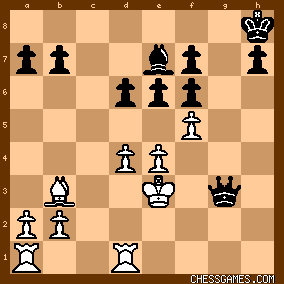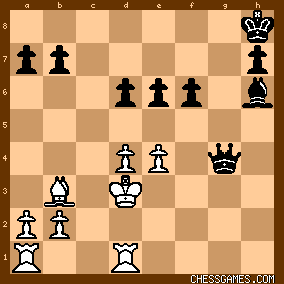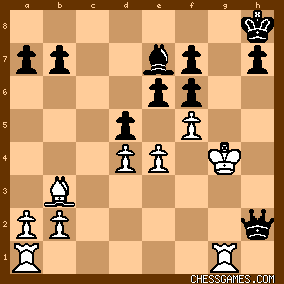|
< Earlier Kibitzing · PAGE 3 OF 3 ·
Later Kibitzing> |
| May-01-08 | | johnlspouge: <<dzechiel> wrote: John is quite right here, but I also think that it's important to select a book that is appropriate to your current skill level.> If you inadvertently imply that in any subject, I might occasionally and senselessly attempt to learn from books beyond my skill level, <dzechiel>, then you are simply getting to know me too well. <When I first got involved in the game ('way back in the dark ages), I read "Chess Traps, Pitfalls and Swindles"> This was probably the first chess book I read seriously, so I endorse <dzechiel>'s recommendation as being completely sensible (as usual :) |
|
| May-01-08 | | Marmot PFL: The Art of Checkmate by Renaud and Kahn is also very good for puzzles like these. Covers all the classic mating patterns. |
|
| May-01-08 | | ClassZPlaya: Also the classic "Art Of Attack in Chess" by Vukovic |
|
| May-01-08 | | johnlspouge: <<Marmot PFL> wrote: The Art of Checkmate by Renaud and Kahn is also very good for puzzles like these. Covers all the classic mating patterns.> Another helpful (if limited) tool for learning checkmate patterns is simply to name them. Leonard Euler, my favorite mathematician, pointed out (in a page I remember selecting <randomly!> at age 16 from one of his books): having the language to describe something enhances your ability to manipulate it mentally. Accordingly, my chessforum maintains a collection of named mates. (Click in this post on my username <johnlspouge> to get to my chessforum.) |
|
| May-01-08 | | euripides: After 23...Rxg2+ 24.Kxg2 Rg8+ 25.Kf2 Qxh2+ 26.Ke3 Rg3+ (otherwise the king can escape to the queenside e.g. Qh3+ 27.Kd2 Qh6+ 28.Kc2) 27.Qxg3 Qxg3+ 28.Ke2 it's not obvious that Black is winning. But Black seems to be able to win more pawns because of the position of the White king e.g. 28...exf5 29.Rg1 Qh2+ 30.Kf3 Qh3+ 31.Kf2 fxe4. White could consider playing 29.exf5 and then jettisoning the f pawn. If White can get his rooks organised then he might be able to stop the pawns advancing. But his king may be too exposed for this to work. |
|
| May-01-08 | | alphee: It's been a while since I visited this site and it's always fun. Nice combination. The first 3 couple of moves were manageable but I couldn't go past those so I checked, doubting that I got the solution, ... but that was it... :-) |
|
| May-01-08 | | wals: static evaluation: Material is even.Black has doubled pawns on the f file.
White has more territory.
Dynamic Evaluation: Do we need somethinng subtle or a decisive blow?
Both kings are well protected on the back rank.
Going for an attack,, Rxg2 Kxg2 (must take or #) Rg8+ seems OK candidate move Rxg2
23. ...Rxg2 24.Kxg2 ...Rg8+ 25.Kf2 ...Qh4+ 26.Ke1 ...Qxh2+ seems enougj for this puzzle PM=
Well three 1/2 moves right are better than none I guess. Move 25 Fritz prefers Kf1to Qg3.
Andrew Soltis - Zdenko Kozul, Palma de Mallorca 1989
Analysis by Fritz 11: Depth 43 time 4 min 34 1.  (-2.75): 23...Rg8xg2 24.Kh1xg2 Rc8-g8+ 25.Kg2-f1 Qh5-h3+ 26.Kf1-e2 Rg8-g2+ 27.Qe1-f2 Rg2xf2+ 28.Ke2xf2 Qh3xh2+ 29.Kf2-e3 Qh2-g3+ 30.Ke3-d2 Qg3-g2+ 31.Kd2-c3 Qg2xe4 32.f5xe6 f7xe6 33.Bb3-c4 d6-d5 34.Bc4-d3 Qe4-f4 (-2.75): 23...Rg8xg2 24.Kh1xg2 Rc8-g8+ 25.Kg2-f1 Qh5-h3+ 26.Kf1-e2 Rg8-g2+ 27.Qe1-f2 Rg2xf2+ 28.Ke2xf2 Qh3xh2+ 29.Kf2-e3 Qh2-g3+ 30.Ke3-d2 Qg3-g2+ 31.Kd2-c3 Qg2xe4 32.f5xe6 f7xe6 33.Bb3-c4 d6-d5 34.Bc4-d3 Qe4-f4 2.  (-0.33): 23...e6xf5 24.Rd1-d2 d6-d5 25.Bb3xd5 f5xe4 26.Bd5xe4 Be7-b4 27.Qe1-e2 Qh5-h4 28.Be4-f5 Bb4xd2 29.Bf5xc8 Qh4xd4 30.Bc8xb7 Qd4xb2 31.Ra1-d1 Qb2xb7 (-0.33): 23...e6xf5 24.Rd1-d2 d6-d5 25.Bb3xd5 f5xe4 26.Bd5xe4 Be7-b4 27.Qe1-e2 Qh5-h4 28.Be4-f5 Bb4xd2 29.Bf5xc8 Qh4xd4 30.Bc8xb7 Qd4xb2 31.Ra1-d1 Qb2xb7 (, 02.05.2008)
|
|
| May-01-08 | | johnlspouge: <<euripides> wrote: After 23...Rxg2+ 24.Kxg2 Rg8+ 25.Kf2 Qxh2+ 26.Ke3 Rg3+ (otherwise the king can escape to the queenside e.g. Qh3+ 27.Kd2 Qh6+ 28.Kc2) 27.Qxg3 Qxg3+ 28.Ke2 <it's not obvious that Black is winning>. But Black seems to be able to win more pawns because of the position of the White king e.g. 28...exf5 29.Rg1 Qh2+ 30.Kf3 Qh3+ 31.Kf2 fxe4.> Toga II 1.3.1 evaluates the line as follows.
[ply 15/58, time 01:25, value (to White) -3.12]
28.<Ke2> Bf8 29.Rg1 Qf4 30.Bc2 exf5 31.Rg2 Bh6 32.exf5 Qxd4 33.Re1 Qxb2 34.Kf1 Qb5+ 35.Kg1 d5 36.Bd3 Qc5+ 37.Kh1 Be3 38.Rc2 Qe7 (The end of the line is included for completeness, but is undependable.) It is obvious to the computer that Black is winning (moreover, Black gains, as the plies deepen, a bad sign for White's positional resources). One presumes what is obvious to a computer was obvious to Soltis as well. Here, as in many imbalances, the Q vs. 2Rs imbalance magnifies collateral advantages for the superior side. Here, the safer K and the better P structure strongly favor Black. |
|
| May-01-08 | | Marmot PFL: <Another helpful (if limited) tool for learning checkmate patterns is simply to name them. Leonard Euler, my favorite mathematician, pointed out (in a page I remember selecting <randomly!> at age 16 from one of his books): having the language to describe something enhances your ability to manipulate it mentally. Accordingly, my chessforum maintains a collection of named mates. (Click in this post on my username <johnlspouge> to get to my chessforum.)> Sorry, I could not connect to the link in your profile. As for Euler, my math history is rusty, was he a student of Gauss? I seem to recall some theorem of his in prime or imaginary numbers and also that he debated Diderot on the existence of God if I am not confusing him with someone else. |
|
| May-01-08 | | LoveThatJoker: Hello out there!
LTJ |
|
| May-01-08 | | johnlspouge: <<Marmot PFL> wrote: Sorry, I could not connect to the link in your profile.> I broke my link by reorganizing my web site (for the last time!). It should work now. <As for Euler, my math history is rusty, was he a student of Gauss?> Euler was a student of the mathematical Bernoulli family (also Swiss), who obviously recognized talent when they saw it. In particular, he showed that pi * pi / 6 = 1 + 1/(2x2) + 1/(3x3) + ...
a sum that several of the Bernoullis had tried to get in closed form, but failed. (Here, pi = circle circumference / diameter). The series essentially drove me into mathematics, as follows. The series can be used to show that (in loose terms) if you choose two numbers at random from the natural numbers 1,2,3,4,..., then the probability that 1 is the largest number that divides the two numbers is 6 / (pi * pi). At age 13, I learned this amazing fact, and finally at age 19, I learned why it must be true. Just think: there is a relationship between circles and division of natural numbers! The universe might be senseless at times, but at others, it is positively profound. <I seem to recall some theorem of his in prime or imaginary numbers> The number
e = 2.718281828459045... = 1 + 1/1 + 1/(1x2) + 1/(1x2x3) + ... bears his initial, because he discovered it. Euler also discovered what some say is the most beautiful formula in all of mathematics: e to the power (i x pi) = -1
<and also that he debated Diderot on the existence of God if I am not confusing him with someone else.> Quite correct. Euler used one of the many specious arguments available to show that 1 = 0, and therefore, God exists. I hope I have not presumed :) I surrender the forum back to chess most happily... |
|
| May-01-08 | | johnlspouge: I have one question, <Marmot PFL>. I used to climb, so your avatar caught my attention. Does it have some significance for you that you can share? |
|
| May-01-08 | | 234: Wednesday puzzle <33. ...?> Apr-30-08 M Trosman vs Salov, 1978 |
|
| May-01-08 | | JohnBoy: Euler pretty much stands as the pinnacle of mathematics as computational tool/technique. He deeply influenced every area of mathematics extant at his time, and created several new ones. He designed a low resistance ship when he was a teenager, winning an international prize - despite having never seen a ship or the ocean. He studied celestial mechanics, trying to establish the stability of the solar system. He introduced analysis to number theory. He discovered and exploited the group structure of elliptic curves, which is fundamental to modern encryption. (Ever send sensitive info over the internet??). He did NOT use a specious argument that 0=1 to establish the existence of god. Rather, he used an amazing variation of 0=0 to claim - well in advance of "intelligent" design - that such beauty cannot exist without there being some underlying deity. Throughout the 19th century he was referred to as "the illustrious Euler". Well worth hitting his name at Wikipedia. Maybe slightly less influential than Newton. |
|
| May-01-08 | | Counterpoint: Anyone who calculated up to this point:
<23...Rxg2 24.Kxg2 Rg8+ 25.Kf2 Qxh2+ 26.Ke3 Rg3+ 27.QxR>
didn't solve the puzzle.
In this position, white has two rooks which makes winning for black very difficult. white also has a strong bishop against black's tenuous central pawns. Therefore one has to recognise that black mustn't exchange his rook until he forces a better position. The fact that there are some 25 complex moves following the puzzle means that a clear win isn't straight forward. 26...Rg5 is brilliant. 1) Black cleverly ties up two rooks and queen with just queen and rook. 2) He releases his bishop with tempo.
3) He mops up white's central pawns while strengthening his central pawn formation 4) The queen and bishop from move 41 onwards disorganize white's three pieces via clever mating threats. Very instructive. |
|
| May-01-08 | | johnlspouge: <<JohnBoy> wrote: He did NOT use a specious argument that 0=1 to establish the existence of god. Rather, he used an amazing variation of 0=0 to claim - well in advance of "intelligent" design - that such beauty cannot exist without there being some underlying deity.> You are quite correct that he did not use a specious argument about 1=0 to prove the existence of God. I probably remember the first, verbal version of the story I encountered. When I check the story with Internet sources, however, the first three Google hits on "leonard euler denis diderot" <Pacific Institute of Mathematics>
http://www.pims.math.ca/pi/issue6/p...
<EDinformatics>
http://www.edinformatics.com/great_... <planetmath.org>
http://planetmath.org/encyclopedia/... give a different equation, certainly nothing to do with 0=0 and intelligent design. Even the Wikipedia article you refer to http://en.wikipedia.org/wiki/Leonha...
gives the same equation. I don't mind being corrected, but next time, please make sure you have your facts straight before you do it. The articles list some of Euler's amazing achievements, if anyone wants a considered summary. The <planetmath.org> article parallels the equations I gave remarkably closely. |
|
| May-01-08 | | MostlyAverageJoe: <Counterpoint: Anyone who calculated up to this point: <23...Rxg2 24.Kxg2 Rg8+ 25.Kf2 Qxh2+ 26.Ke3 Rg3+ 27.QxR> didn't solve the puzzle ... one has to recognise that black mustn't exchange his rook until he forces a better position.> The above statement is 100% incorrect IMHO. In the quoted line there is NO way that black can delay exchanging the rooks. Any black's deviation from the moves in that line is good for white. In any case, after 27...QxQ+, it is fairly clear that the white pawns will be falling: 
click for larger viewIf white refuses to leave the e-rank (which would enable black to take the e4 pawn), placing black Q on g4 prevents white from a major pawn grabbing, e.g.: 28. Ke2 Qg4+ 29. Ke3 Bf8 30. fxe6 Bh6+ 31. Kd3 fxe6 and black is OK: 
click for larger viewFor Thursday puzzle, I doubt whether 15-ply depth of analysis is really necessary. |
|
| May-01-08 | | johnlspouge: <<Counterpoint> wrote: Anyone who calculated up to this point:
<23...Rxg2 24.Kxg2 Rg8+ 25.Kf2 Qxh2+ 26.Ke3 Rg3+ 27.QxR> didn't solve the puzzle. In this position, white has two rooks which makes winning for black very difficult. [snip]> Toga II 1.3.1 evaluates the best play from 27.<Qxg3> as [ply 15/51, time 00:58, value (to White) -3.23]
27.Qxg3 Qxg3+ 28.Ke2 Qg2+ 29.Ke3 Bf8 30.Rh1 Qg3+ 31.Ke2 Qf4 32.Bc2 exf5 33.exf5 Qxd4 34.Kf3 d5 35.Rae1 Qxb2 36.Bb3 Qd2 37.Re8 (For completeness, I include the entire line, which is likely inferior at its end.) At value -3.23, the position is a clear win for Black. Even without accruing material, Toga evaluates the position at -1.60, i.e., a clear P ahead with something to spare. |
|
| May-01-08 | | johnlspouge: <<MostlyAverageJoe> wrote: The above statement is 100% incorrect IMHO.> I should learn to voice differences of opinion as delicately as you do, <MAJ> ;>) A pleasant exchange with <A.G. Argent> reminded me of the movie "Tombstone", which I was watching tonight. It's nice to have you back in town, Wyatt :) |
|
| May-01-08 | | DavidD: ...Rxg2 is a "natural" move that a strong player would certainly examine, mostly likely first among the candidate moves. The analysis seems a bit complicated based on other posts, but it is still the type of move that "feels right", at least enough to look at carefully. These puzzles point out the need to examine each capture and check of the opponent before making a move, no matter how silly the move looks. It's a good question to ask why a strong GM like Soltis didn't seem to anticipate or see Black's attack after ...Rxg2. The answer is that he probably just didn't even look at ...Rxg2. It really is good advice to follow: Look at each capture and check before you make a move! |
|
| May-01-08 | | MostlyAverageJoe: <Counterpoint: The fact that there are some 25 complex moves following the puzzle means that a clear win isn't straight forward.> If I may be excused for introducing an opinion with a tiny hint of disagreement, perhaps the length of the remaining game might have been influenced to some degree by black playing 27. ... Qxe4 instead of 27. ... Rh5+. The latter move, mentioned earlier by <RandomVisitor>, appears to accelerate the resolution of the game and appears to be quite natural to my patzer self. The game could evolve thus: 27. ... Rh5+! 28. Qh4 (forced)
Regretfully I find myself in a disagreement with <RV>'s d5 and propose that white should exchange the rook right away: 28... Rxh4+! 29. Kxh4 (forced) Qxh2+ 30. Kg4 (forced) and now is the time to play
30. ... d5!

click for larger viewThe resulting position appears to be unenviable for white. Hiarcs evaluates it as (-10.77), quite a leap from the (-2.75) of the line played in the game (27...Qxe4). |
|
| May-01-08 | | johnlspouge: <<MostlyAverageJoe> wrote: If I may be excused for introducing an opinion with a tiny hint of disagreement [snip]> G'night, <MAJ>. Enjoy yourself :) |
|
| May-02-08 | | zooter: <johnlspouge>
Agreed...will try to make more mistakes and cut down on mistakes and give more insightful points |
|
| May-02-08 | | whiteshark: Two recently observed games/puzzles with black g-file attacks (Rxg2+) were: S Andriasian vs D Harika, 2006
Shumov vs Kolisch, 1862
|
|
| May-07-08 | | JohnBoy: <johnlspouge - I don't mind being corrected, but next time, please make sure you have your facts straight before you do it. >: Thanks for the comments. I am quite comfortable with my facts, though. The story as it appears in various places is the same, but with the equation e^(i*pi)+1=0 (hence the 0=0 to which I referred). Very standard introductory complex arithmetic. Trivial if you know the stuff. It is given in the Wikipedia reference you mention, with the comment "called 'the most remarkable formula in mathematics' by Richard Feynman". Whether your equation or mine is the actual one, mine certainly holds content and might well have been used by Euler (to whom it is due), while yours is gobbledy-gook. Secondly, if my slightly different version of a probably apocryphal event is true, then Euler tried to brow-beat his debate foe by reasoning that such beauty and structure - as demonstrated by the above equation - can only exist at the hands of god. He did not make any claims regarding intelligent design. But this mode of reasoning is used by proponents of ID. This is what I was referring to. You might read "The God Delusion" for details on specious agruments supporting the existence of god. If the equation is as you say, then it is gibberish and Euler tried to brow-beat his foe with the equivalent of "ooga-booga, and I know because I am an EXPERT!". Again, a line of reasoning used often by ID proponents (although not uniquely by any means). I seem to have touched a nerve. Sorry if I offended you. |
|
 |
 |
|
< Earlier Kibitzing · PAGE 3 OF 3 ·
Later Kibitzing> |
|
|
|





